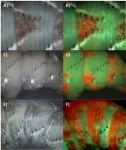Reconstruction of historical seasonal influenza patterns and individual lifetime infection histories in humans based on antibody profiles
2024-11-07
(Press-News.org)
Reconstruction of historical seasonal influenza patterns and individual lifetime infection histories in humans based on antibody profiles
#####
In your coverage, please use this URL to provide access to the freely available paper in PLOS Biology: http://journals.plos.org/plosbiology/article?id=10.1371/journal.pbio.3002864
Article Title: Reconstructed influenza A/H3N2 infection histories reveal variation in incidence and antibody dynamics over the life course
Author Countries: United Kingdom, China, United States
Funding: see manuscript
END
ELSE PRESS RELEASES FROM THIS DATE:
2024-11-07
UNDER EMBARGO UNTIL 19:00 GMT / 14:00 US EASTERN TIME THURSDAY 7 NOVEMBER 2024
Increased capabilities for genomic surveillance have offered new insights into global viral evolution;
Seasonal flu showed a ‘remarkable’ bounce back to pre-pandemic levels once international air travel resumed;
Regions with fewer COVID-19 restrictions were associated with sustained flu virus transmission.
Seasonal influenza epidemics impose substantial burdens on healthcare systems and cause >5 million hospitalizations of adults each year. The current approach to influenza vaccine development requires comprehensive surveillance ...
2024-11-07
Named after the two-faced Roman god Janus to reflect its dual-purpose design, researchers present a novel membrane system – a Janus channel of membranes (JCM) – capable of simultaneously separating oil and water from complex emulsions. The system addresses a critical challenge for sustainable water and oil reclamation across various industries. Separating oil and water from complex mixtures is essential for many scientific and industrial applications, such as wastewater treatment and biological sorting. Membrane ...
2024-11-07
Although travel restrictions and social measures during the COVID-19 pandemic led to a dramatic global drop in seasonal influenza cases, certain influenza lineages in specific regions kept the virus circulating and evolving, according to a new study. This was true in tropical areas with fewer travel restrictions, for example, including South and West Asia. The spread of seasonal influenza is closely tied to social behavior, particularly air travel, and to the periodic evolution of new virus strains that evade immunity from prior infections or vaccinations. In 2020, nonpharmaceutical interventions (NPIs) introduced to combat COVID-19 – such as ...
2024-11-07
Disruptions between the brain’s master circadian clock and the liver’s internal clock, communicated via the hepatic afferent vagal nerve (HVAN), can lead to unhealthy eating patterns and increased weight gain, according to a new study in mice. The findings identify the neural link as a potential therapeutic target for obesity and metabolic dysfunction related to circadian disruption. In mammals, circadian rhythms are controlled by the suprachiasmatic nucleus (SCN) – a small part of the brain’s hypothalamus that regulates the body’s circadian rhythms. This cycle triggers a feedback loop involving key clock genes that keep ...
2024-11-07
“Wet dog shakes” – a common reflex behavior shared among many hairy mammals and designed to expel water and irritants from their coats – happens when particular mechanoreceptors are activated, researchers studying mice report. Many furry mammals engage in rapid body twists known as "wet dog shakes" to effectively remove water from their fur, as well as to eliminate irritants like tangles or parasites, particularly in areas on the neck and back that are largely unreachable by self-grooming or licking. However, despite the commonality of this behavior ...
2024-11-07
PHILADELPHIA— People who work the nightshift or odd hours and eat at irregular times are more prone to weight gain and diabetes, likely due to eating patterns not timed with natural daylight and when people typically eat. But is it possible to stave off the ill effects of eating at these “unusual” times despite it not being biologically preferable? A new study from the Perelman School of Medicine at the University of Pennsylvania says ‘yes’, and sheds light on how the body knows when to eat. The study, published today in Science, explains how researchers discovered a connection between the liver's internal clock and feeding centers in the ...
2024-11-07
The more a plant species invests in defense, the less potential it has for growth, according to a new study. Research made possible by open science provides new insights into plant adaptation and interspecies variation.
Pathogens can significantly weaken the fitness of their hosts, sometimes even causing host mortality. Yet considerable variation is found between species in their investment in disease defense. Evolutionary theory predicts that allocation costs regulate this investment, but testing this hypothesis ...
2024-11-07
Hip implants with a delta ceramic or oxidised zirconium head and highly crosslinked polyethylene liner or cup had the lowest risk of revision during the 15 years after surgery, a new study led by the University of Bristol has found. The research could help hospitals, surgeons and patients to choose what hip implant to use for replacement surgery.
The aim of the study was to establish hip implant materials at risk of revision to help orthopaedic surgeons, and patients, and to improve shared decision making ...
2024-11-07
Most research on plant stem cells focuses on the tips of roots and shoots, where growth occurs in height. But Ten Tusscher explains that thickness growth is just as essential. “Plants can’t grow endlessly in height. They also need to grow in thickness, or they would simply fall over,” she says. The growth in thickness, is what makes older trees visibly thicker and more robust over time. This growth is essential for structural strength, particularly in trees.
Stem cells in the plant’s cambium layer control this width growth, producing wood to support the plant’s structure. However, which genes enable these cambium stem cells to become active ...
2024-11-07
University of Maryland entomologists uncovered a unique relationship between two species of fungi known for their ability to invade, parasitize and kill insects efficiently. Instead of violently competing for the spoils of war, the two fungi peacefully cooperate and share their victims.
The findings, published in the journal Public Library of Science (PLOS) Pathogens on November 7, 2024, offer insight into some of the biggest evolutionary successes in nature’s history, according to study co-authors Raymond St. Leger, a Distinguished University Professor of Entomology, and entomology Ph.D. candidate Huiyu Sheng.
“It’s not survival ...
LAST 30 PRESS RELEASES:
[Press-News.org] Reconstruction of historical seasonal influenza patterns and individual lifetime infection histories in humans based on antibody profiles




